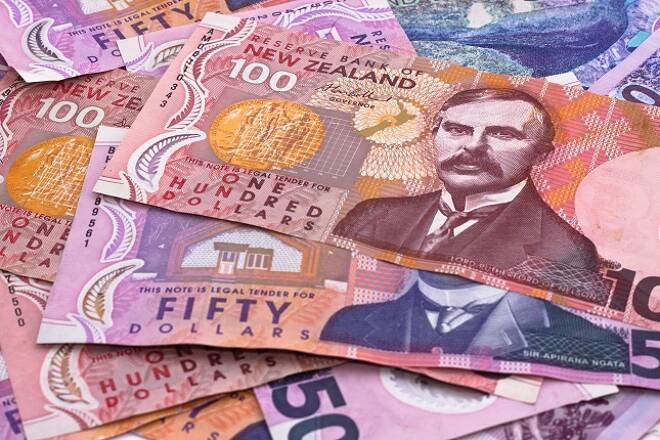Advertisement
Advertisement
Weekly Recap – New Zealand CPI Sinks Kiwi; Better China GDP, Domestic Jobs Data Not Enough to Save Aussie
By:
Given the new CPI data, New Zealand economists are now predicting the Reserve Bank will cut its official cash rate from its present record low at 1.75 percent to 1.5 percent in May. Although traders are pricing in an RBA rate cut for later in the year, the employment report may have bought the central bank a little time. The AUD/USD price action suggests that traders may have increased bets the RBA will not rush to ease rates even though the broader economy has seemingly lost momentum.
The New Zealand and Australian Dollars finished the holiday-shortened week lower as fears of central bank rate cuts dominated the trade along with mixed domestic data and stronger-than-expected Chinese economic data.
Stronger-than-expected U.S. economic data also influenced the trade as it continued to indicate moderate to stronger growth, while dampening the chances of an economic slowdown and a rate cut by the Fed later in the year.
Last week, the NZD/USD settled at .6687, down 0.0075 or -1.10% and the AUD/USD finished at .7151, down 0.0021 or -0.29%.
Kiwi Pressured by Weak CPI Data
After opening the week steady, the New Zealand Dollar took a dive on Wednesday and never recovered, finishing near its low for the week. The catalyst behind the selling pressure was weaker-than-expected consumer inflation data. The bearish news was offset slightly and temporarily by positive economic data from China and the New Zealand government’s decision to shelf an ill-timed capital gains tax.
Statistics New Zealand said the Consumer Price Index (CPI) for the quarter ending in March came in at 0.1 percent, below market expectations of about 0.3 percent and the Reserve Bank’s 0.2 percent forecast. That figure also took the annual inflation rate to 1.5 percent, below the central bank’s 2 percent target.
Given the new CPI data, New Zealand economists are now predicting the Reserve Bank will cut its official cash rate from its present record low at 1.75 percent to 1.5 percent in May.
In other news, Prime Minster Jacinda Ardern said the public has spoken and she won’t introduce a capital gains tax while she leads the Labour Party. The news produced a small technical bounce in the Kiwi, but not enough to change sentiment.
Aussie Reacts to Mixed Economic News
The Australian Dollar reacted to mixed economic news by posting a choppy, two-sided trade before setting lower for the week.
The Aussie edged lower shortly after the Reserve Bank released the minutes of its April meeting that indicated a dovish tone in the policy review.
The minutes showed that policymakers saw a marked slowdown in the Australian GDP that offset the sustained labor market growth. The minutes also revealed that policymakers expect inflation to remain muted for some time. Additionally, the minutes disclosed the RBA discussed interest-rate cuts at its April board meeting and concluded there was “not a strong case” for an adjustment in the near term.
RBA board members conceded interest rates were unlikely to need to rise in the near future and decided standing pat would allow it to be “a source of stability and confidence.” In doing so, it noted the impact of further easing would be “smaller than in the past” because of high household debt and declining property prices.
The AUD/USD was also boosted by data from China which showed its economy grew at a 6.4 percent annual pace in the first quarter, above expectations for a 6.3 percent growth rate. Additionally, Industrial Production rose 8.5%, beating the 5.6% forecast. Retail Sales rose 8.7%, better than the 8.3% estimate.
Finally, the Aussie Dollar had a mixed reaction to Australian jobs data. The Employment Change report showed a total 25,700 new jobs were created in March, surging past expectations for a rise of 12,000. Most impressive was that all of the increase was led by full-time work with part-time decreasing 22,600.
Additionally, the unemployment rate rose to 5.0 percent in March from an eight-year trough of 4.9 percent the previous month as the participation rate climbed to 65.7 percent in a sign more people went looking for work.
Although traders are pricing in an RBA rate cut for later in the year, the employment report may have bought the central bank a little time. The AUD/USD price action suggests that traders may have increased bets the RBA will not rush to ease rates even though the broader economy has seemingly lost momentum.
About the Author
James Hyerczykauthor
James Hyerczyk is a U.S. based seasoned technical analyst and educator with over 40 years of experience in market analysis and trading, specializing in chart patterns and price movement. He is the author of two books on technical analysis and has a background in both futures and stock markets.
Advertisement
